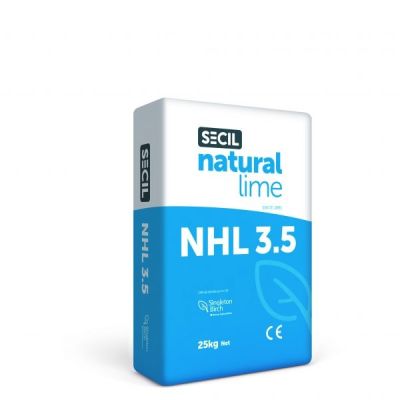Application - Hydraulic Lime Mortar Application
Bethany Evans Posted this on 08 Apr 2024
Preparing the mix
- Mix the lime and aggregate by volume (check the specification for exact mix ratio for the job or refer to the table below), measuring of material must always be with a gauging box or bucket. The sand/aggregate should be sharp, well-graded and washed.
- A conventional cement mixer can be used although for larger projects a roll pan or paddle mixer is preferable. Lime mortars mixed in drum mixers can be prone to balling but use of particular mixing techniques can reduce this. Switch the mixer on and dampen down the inside of the drum as this will help to reduce the amount of dust and prevent the lime from sticking too much. Switch the mixer off before adding two thirds of the water and half of the sand followed by all of the lime. Switch the mixer on, allow the water to thoroughly disperse throughout the mix (15-20 minutes) before adding the rest of the sand and more water if required. You will have to experiment for the first mix as the quantity of water will vary with sand moisture content – but be CAUTIOUS, for a 3:1 mix, initially add 6 litres of water, 30 litres of sand and then 20 litres of lime, mix, then add the remaining sand and adjust the water.
- Use the mix within 2 hours.
- Keep the mortar stiff - mortar for pointing should be kept stiff and dry in order to compress it into the joint without smearing. Take care not to get mortar onto the face of the brick/stonework. Mortar for laying bedding work needs to be a little wetter but should still be kept as stiff as possible to avoid excessive shrinkage. The mortar needs to be just wet enough to be workable.
Pointing - Preparing the surface
- Loose, existing mortar must be raked out and dust removed, usually to a depth equal to twice the width of the joint. Sound mortars should be left. Great care should be taken if removing a hard, cement mortar as damage can easily be done to the stone/brickwork.
- Dampen all stones/bricks and adjoining surfaces by spraying with water or immersing in water, otherwise they will ‘suck’ the moisture out of the mortar before it carbonates/sets, causing it to fail.
Application
- Trials/test panels should be produced to find the appropriate tools and methods for achieving the correct finish and colour for the building.
- Large holes should be packed with lumps of stone or bricks, as large volumes of mortar will shrink.
- Push the mortar firmly into the joint to avoid voids in the wall.
- Bring out mortar joints in layers of up to 10 - 15mm thick to allow carbonation, using a pointing or finger trowel from a small plastic hawk.
- Leave each coat until it is hard i.e. set, but not dried out - the mortar should be ‘too hard to dent with a knuckle and soft enough to mark with a thumbnail’.
- It should be left to ‘stiffen up’ for up to 24 hours (depending on the speed of drying).
- Brush or scrape back when firm with a churn brush, to compress and achieve desired finish. The ideal is to finish the mortar flush with the stone/brickwork so as not to create ledges for the water to sit on. A good, even surface is the best protection for the building. This is an important process to get right for the long-term success of the job.
Protection & after care for hydraulic lime mortars
Effects of rain and temperature
Without doubt the most significant difference to the user between OPC and lime-based mortars is the rate of build in cold weather. This can result in:
- Slower rate of laying.
- Requirement for protection against water saturation and frost. In mild winter weather work with hydraulic lime mortars can proceed normally provided there is provision of immediately available protection in the event of rain and/or frost. e.g. hessian and tarpaulin. In order to understand the need for protection, specifiers and contractors should appreciate that the rate of set of hydraulic lime is more dependent on temperature than cement.
While mortars laid in the summer months may achieve frost resistance in a month, work done at cooler times of the year will undoubtedly take much longer and will therefore require protection from frost longer too - perhaps for the remainder of the winter. Without doubt the worst combination is heavy rain followed by clear skies and a frost. Saturated walls with under-strength mortars will suffer frost damage much more easily than walls protected from the rain. Driving rain poses less of a risk than rain entering from the top of the wall. As a precaution, covers (e.g. tarpaulins) should be placed on the top of the work overlapping, say 300mm each side will do much to keep the wall dry thereby reducing the risk of damage.
Another factor to bear in mind relates to porosity of masonry units. Porous materials hold very large quantities of water. Lime mortars are designed to aid evaporation. This process of evaporation causes a drop-in temperature, so the mortar in new walls holding large quantities of water will set slower because of this drop-in temperature. A great deal of the water in the masonry units will evaporate out through the mortar joints. This effect will ensure a permanently low temperature in the lime mortar until the whole wall begins to dry. Cement mortars are much less permeable and a high percentage of the water will have to evaporate from the face of the masonry units. As stated previously wet masonry is much more vulnerable to frost. Frost protection is essential.













